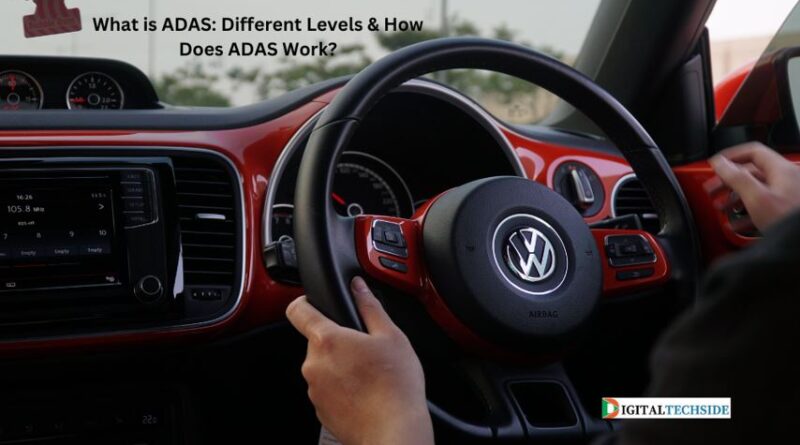What is ADAS: Different Levels & How Does ADAS Work?
Advanced driver-assistance systems, or ADAS, are high-tech upgrade software that is designed to make vehicles safer. Designed carefully, they are intended to boost the driver’s ability to react to dangerous road situations using several levels of automation. There are different levels of ADAS, each providing different kinds of help to the driver.
In this article, let’s discuss how this works in fleet management.
How ADAS Software Works
Advanced Driver-Assistance Systems (ADAS) integrate a variety of technologies, including cameras, LiDAR (Light Detection and Ranging), radars, sensors, and complex software algorithms, to enhance vehicle safety. Systems on a chip (SoCs) are paramount to the functioning of ADAS, as they act as the central processing unit by receiving, interpreting, and responding to signals from various vehicle components.
● SoCs
SoCs are designed with interfaces to connect to different sensors and actuators in the vehicle. These sensors capture data from the physical environment, such as obstacles or traffic signals.
● Actuators
Actuators, on the other hand, respond to the signals transmitted from the SoCs to execute physical actions, like accelerating, braking, or steering the vehicle. SoCs act as bridges between these devices, enabling the continuous interplay of receiving real-world data and responding with appropriate physical actions.
● ECUs
The power and agility of the SoCs come from their on-chip ECUs. They are equipped with advanced microprocessors that make real-time decisions based on the data received from sensors feeding into Machine Learning (ML) and Artificial Intelligence (AI) algorithms.
The ECUs process data from various sensors and control electronic systems within the vehicle, such as adaptive cruise control, automatic emergency braking, and lane-keeping assistance. Therefore, the high-performance ECUs embedded in SoCs hold an important role in handling this sensor data, interpreting it, and transmitting precise control signals to various vehicle components.
What are the Different Levels of ADAS?
The effectiveness of advanced driver assistance systems is not absolute but varies across six distinct levels, each offering different features. Beginning at Level 0 and advancing to Level 6.
● Level 0: No Automation
This is the most basic level where there is no automation at all; the driver controls everything manually. In other words, at Level 0, ADAS does not control the vehicle but can provide warnings to the driver.
● Level 1: Driver Assistance
At this level, the vehicle can assist the driver with either steering or speed control, but not both simultaneously. This means there might be features like adaptive cruise control (ACC), where the vehicle maintains a safe distance from the vehicle in front, or lane-keeping, where it helps steer the vehicle into the correct lane. However, the vehicle is still under the driver’s primary control.
● Level 2: Partial Automation
This is where the vehicle can control both steering and speed simultaneously, but under no circumstances is the vehicle is in complete control. The driver still has to monitor the situation and intervene when necessary. Also, the driver is not required to monitor the environment continuously
● Level 3: Conditional Automation
At this level, the vehicle can handle a substantial portion of driving, including monitoring the environment. The driver may even be able to focus on other activities, like adjusting the radio or having a drink. However, the driver has to be ready to take control when the vehicle indicates.
● Level 4: High Automation
These vehicles can perform all driving functions under certain conditions. And it only requires human interaction to set the destination. In other words, the vehicle can be driven entirely by the system under specific conditions. The driver may not be required to intervene and can turn their attention away from the driving task
● Level 5: Full Automation
The vehicle is in complete control; it doesn’t need any human input after the destination has been set. These are the kinds of autonomous vehicles often depicted in futuristic movies.
Keep in mind that as of today, most vehicles on the road fall somewhere between Levels 0 – 2, and Levels 3 – 5 are still very much in testing or early adoption stages.
Advanced Driver Assistance Software Features
It’s fascinating to imagine the possibilities if you had the added advantage of extra vision or an increased sensory perception while driving. This is exactly what ADAS systems offer. Incorporating them into fleets, whether commercial or personal, carries the potential for a transformative impact on the overall driving and commuting experience.
Advanced Driver Assistance Systems (ADAS) are a variety of tech-based systems that work in the background to support drivers on the road, improving road safety by mitigating the chance of human-error-related accidents. By incorporating ADAS into fleets, management can achieve improved efficiency, safety, and command over various aspects of their operation.
Your ADAS software must be equipped with these features so it can help your fleet in the long run.
- Adaptive Cruise Control (ACC): This system automatically adjusts the vehicle’s speed to maintain a safe distance from other vehicles. In a fleet context, ACC can reduce instances of rear-end collisions.
- Automatic Emergency Braking (AEB): This system can detect potential collisions, warn the driver, and apply the brakes if necessary. In fleets, this can limit accident rates, resulting in lower insurance costs.
- Lane Departure Warning (LDW): This warns drivers when the vehicle begins to drift out of its lane without the turn signals activated. This function is particularly impactful in preventing sideswipe and rollover accidents in fleets.
- Blind Spot Detection (BSD): This function notifies the driver when an object, usually another vehicle, is in the blind spot. For fleets, BSD can massively reduce potential side and lane change accidents.
- Driver Monitoring Systems (DMS): These systems observe and analyze the driver’s behavior and physical condition, looking for signs of distraction or fatigue. If detected, the system will alert the driver. It’s particularly applicable in fleets with long-distance drivers and different shifts.
Conclusion
Advanced driver assistance systems enhance the driving experience and increase overall road safety, especially when it comes to fleets.
With ADAS, managers get alerts before a part reaches the end of its life cycle. This lets them schedule regular maintenance, extending the vehicle’s life and preventing a sudden part failure that could lead to an expensive repair or, worse, an accident.
Just like a volume dial, ADAS can be turned up and down to match almost any situation, from no assistance at all to comprehensive, full-time automation.
So, why not upgrade your fleet management with TrackoBit’s ADAS software? Call us and get your customized software ready in no time.
Read More: What is Advanced Driver Assistance System (ADAS)?

As a DIGITALTECHSIDE author, the majority of our articles have been focused on technology, blogging, business, lifestyle, social media, web design and development, e-commerce, money, health, education, entertainment, SEO, travel, and sports.
Contact us at digitaltechside@gmail.com if you have questions of anything.




